4/1/2019
Open Channels
Ronda Payne

People who start garden supply companies naturally bring a love of the land to their businesses, but Will Raap took things several steps further in 1983 when he founded Gardener’s Supply Company. According to Jim Feinson, COO, and Max Harris, Chief Marketing Officer, of Gardener’s Supply, Will saw that the Intervale region of Burlington, Vermont, was a far cry from the bread basket it had been in the Colonial era. In fact, the region was about as far from an agricultural center as it gets. The municipal dump opened on a portion of the land in the ’40s and the 700-acre Intervale literally became a dumping ground complete with tires, furniture and abandoned cars, along with rail lines, a highway and a pig farm.
“Will had a vision that the Intervale could be returned to agriculture,” says Max. “So, as a first step, he put the company there. Today, the Intervale is a model of agricultural sustainability with Gardener’s Supply Company and the non-profit Intervale Center, which we started, as its anchor tenants.”
The Intervale Center is a 360-acre site on the Winooski River that features farmland, trails and farms that produce vegetables, host bees, grow flowers, cultivate medicinal herbs and more.
The Evolution Begins
Gardener’s Supply spent those early days as a catalog-based direct mail company, which is still an important aspect of the business, but as Max explains, it was 1994 when the company launched its first website and moved from being single-channel in its sales strategy.
“We were an early adopter of digital marketing and have long embraced the power and vision of being omnichannel,” Max says. “Catalogs remain an integral part of our marketing mix, but increasingly they will act more as a traffic driver to the website and garden centers rather than a direct purchase channel.”
Being an early adopter came with its share of challenges. That first website was part of something known as a cybermall, which didn’t lead to any business. Then the cybermall went bankrupt.
“We were smart enough to escrow the code, meaning [we ensured] we had rights and access to the code behind the website, so we could keep our website up and running,” Jim says. “We did not do any meaningful business [through the site] until 1996 or later.”
Even as sales began through the website, the team at Gardener’s Supply only saw the Internet as a different method for customers to place their order while looking at the catalog.
“We thought the gain would be in operations costs,” he notes. “We had no vision that it would become the marketing engine it is today.”
Megasites were also tried in the early years. The original, but now defunct, garden.com, myseasons.com and etera.com. “Only by being flexible and agile, while not over-committing, have we been successful,” says Jim.
Looking at the Big Picture
Now, more and more of Gardener’s Supply Company’s marketing budget is invested in digital activities, like search marketing, social marketing and online presence with Amazon and Walmart in addition to the company’s website, email campaigns and other digital assets. However, both Jim and Max stress that the online activities, three physical retail locations and catalog/direct mail channels are all managed as parts of an overall portfolio.
“It often takes multiple consumer touches to generate a sale or even a visit,” explains Max. “The portfolio approach lets us shift [marketing] spend into programs that are driving better results.”
Gardener’s Supply refuses to do things many retailers have for years: “Selling the same old way,” according to Jim. There’s a lot of talk about attribution models (the art of determining which touchpoint led to a sale—whether it was one of the brick-and-mortar locations, the website, the toll-free customer line, catalog or something else) to decide the right areas for more budget or less.
“We continue to invest heavily in our online program: product development, content, website features and lots and lots of marketing,” says Jim. “As we all know, the Internet customer behaves differently and interacts with brands differently than through traditional retail or even catalog marketing.”
This shift in consumer behaviors keeps Gardener’s Supply working and moving in new directions in order to gain and maintain connections with all gardeners, particularly the younger set, and ensure they’re meeting them at their preferred touchpoint. The company makes use of the data they’ve gathered over time to create test offers and ads, customize shopping experiences and tell the story about the company. It’s one of the competitive advantages Gardener’s Supply holds from being in the business for 35 years and staying willing to look at new opportunities.
“As a social mission-driven organization, we want to use the Internet to make a brand connection with customers who care about where they shop,” Jim says.
The brand assumed a new physical location outside of Vermont in 2018, purchasing Longacres’ Nursery garden center in Lebanon, New Hampshire. The company now has three retail stores. The first year was a successful one according to Max.
“We envision the acquisition of more garden centers as a key part of our strategic growth plan,” he notes.
 Pictured: Gardener’s Supply Leadership Team (from left to right): Christie Kane, VP of Human Resources and IT; Max Harris, Chief Marketing Officer; Rebecca Gray, VP of Merchandising; Cindy Turcot, President; Jim Feinson, Chief Executive Officer; and Gina Bernadet, Chief Operations Officer.
Pictured: Gardener’s Supply Leadership Team (from left to right): Christie Kane, VP of Human Resources and IT; Max Harris, Chief Marketing Officer; Rebecca Gray, VP of Merchandising; Cindy Turcot, President; Jim Feinson, Chief Executive Officer; and Gina Bernadet, Chief Operations Officer.
This success is due kudos, given the challenges in the garden supply retail space thanks to shifts in consumer shopping habits and online habits. Shoppers carry their phones everywhere, live in their homes later in life than their parents or grandparents and are more likely to have beloved pets they treat as family. Add the increased multicultural profile and some garden supply retailers are wondering how to cater to new consumer trends. Jim says Gardener’s Supply sees the challenges, but is more motivated to think about what each channel is best at. There’s a desire to integrate the customer’s experience across channels to serve the customer the way they choose.
“Each channel continues to change so quickly, so the overall management approach is not staying stuck where you are, but to be willing to take risks and try new things,” he notes. “But at the core, you need to know who you are, the essence of your brand and that is what must come through with consistency across channels, even if the different channels emphasize different products or sell in different ways.” GP
A writer since she could hold a pen, Ronda Payne is passionate about words. In 2007, she kissed “real jobs” goodbye and began her true occupation as a full-time copywriter, freelancer and storyteller. She’s a regular contributor to a range of publications with an emphasis on those in agriculture. Ronda joyfully lives in Maple Ridge, B.C., Canada, in yet another renovation project home with her husband and their pets.
“It often takes multiple consumer touches to generate a sale or even a visit. The portfolio approach lets us shift [marketing] spend into programs that are driving better results.”
—Max Harris, Chief Marketing Officer of Gardener’s Supply
Data Blast: Gardener’s Supply
1983 Founded
100% Employee Owned
225 Employees
6 Physical Locations (3 Garden Centers, 3 Corporate/Manufacturing/Distribution Facilities)
4622 SKUs
16 million Catalogs Produced in 2018
8% Profits Donated to Nonprofit Organizations Each Year
Employee Owned and Driven
After founding Gardener’s Supply in 1983, founder Will Raap had a vision of community sustainability and culture when he started integrating employee ownership into the company in 1987.
“He wanted those of us who built the company to eventually own and control the company,” explains Max Harris, Chief Marketing Officer of Gardener’s Supply.
 Being a shareholder is important, but there’s more to it than just owning part of the company—it’s about thinking, being and acting like an owner. Each employee learns about the rights and responsibilities of being an owner, while also understanding how their job contributes to the company’s success. It’s a model that allows the organization to thrive and persist, even when the going gets tough.
Being a shareholder is important, but there’s more to it than just owning part of the company—it’s about thinking, being and acting like an owner. Each employee learns about the rights and responsibilities of being an owner, while also understanding how their job contributes to the company’s success. It’s a model that allows the organization to thrive and persist, even when the going gets tough.
Pictured: Erin Kirkpatrick, Email Marketing Manager, shows off some of the harvest destined for the Chittenden Emergency Food Shelf. Gardener’s Supply employee-owners grow organic produce across their business facilities each year to donate to local hunger-relief organizations.
“Great ideas can come from any employee and often the best ideas come from those closest to the work,” says Jim Feinson, Chief Executive Officer. “We believe and expect every employee owner should contribute beyond his or her direct responsibilities and we try to give them the opportunity every chance we can.”
Jim says employee-owned companies tend to outperform non-employee owned counterparts. Plus, because employees have a broader exposure to how the company operates, they have a greater understanding of the organization and may welcome advancement opportunities. The model ensures a strong pool of solid employees who care about the value in their share account, but also about altruistic company objectives.
“Garden center owners who are selling their businesses to Gardener’s Supply can feel good that their staff will benefit from a transition because the staff get to become owners like everyone else,” says Jim.